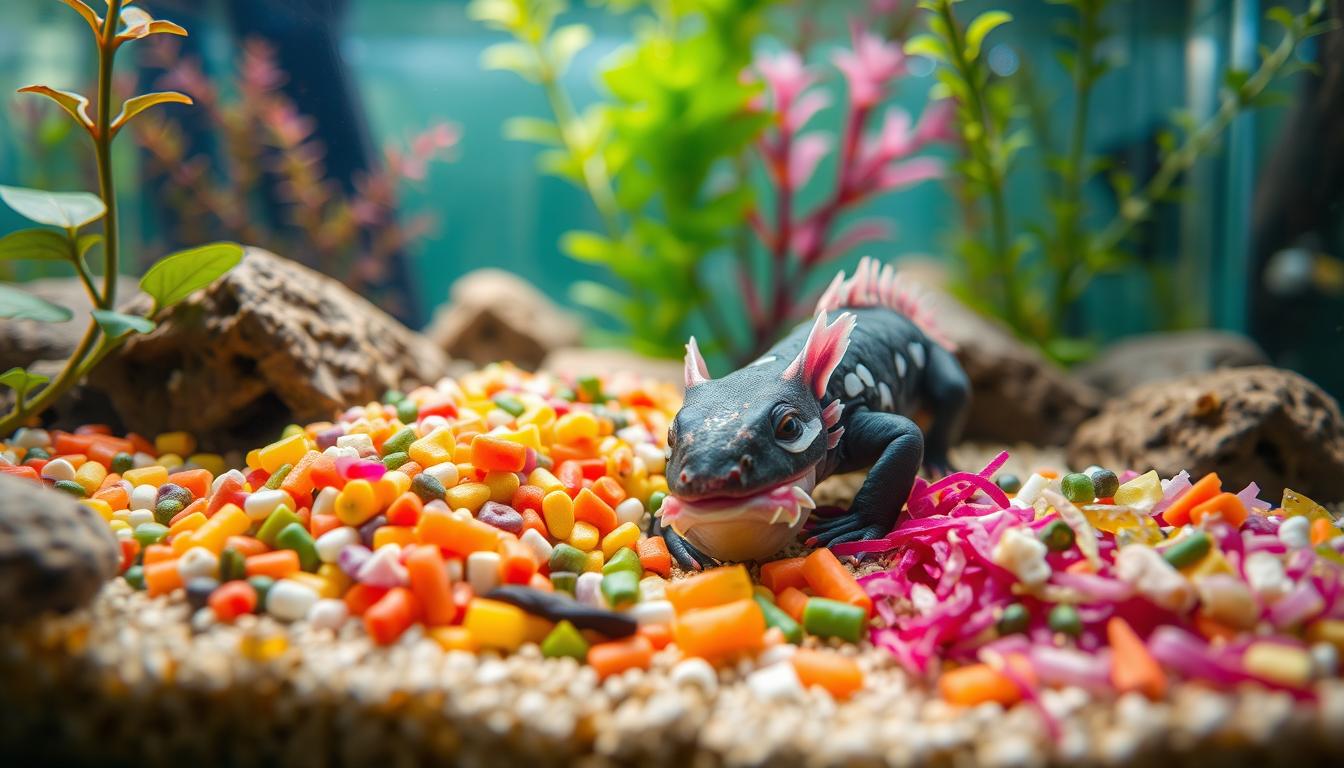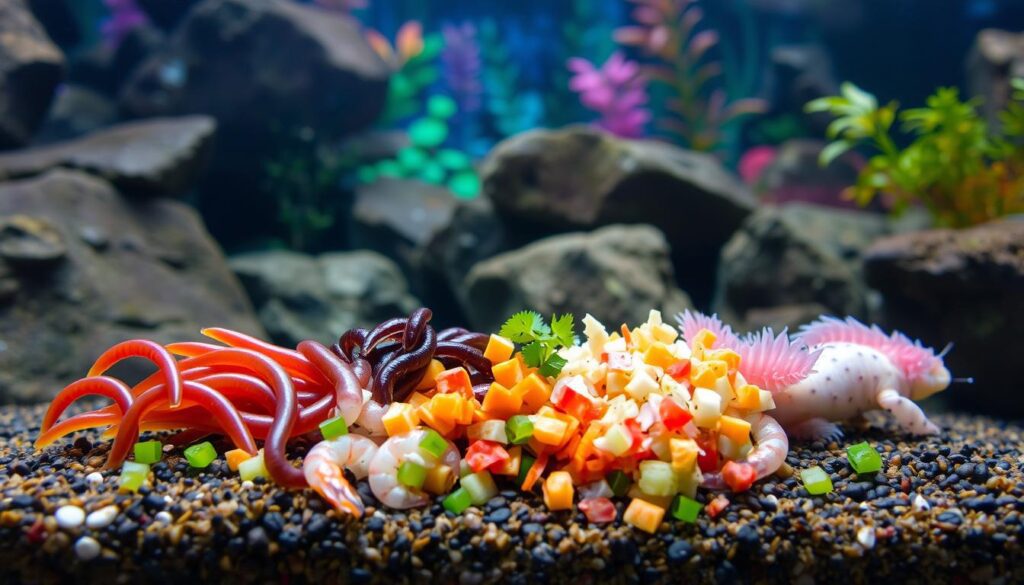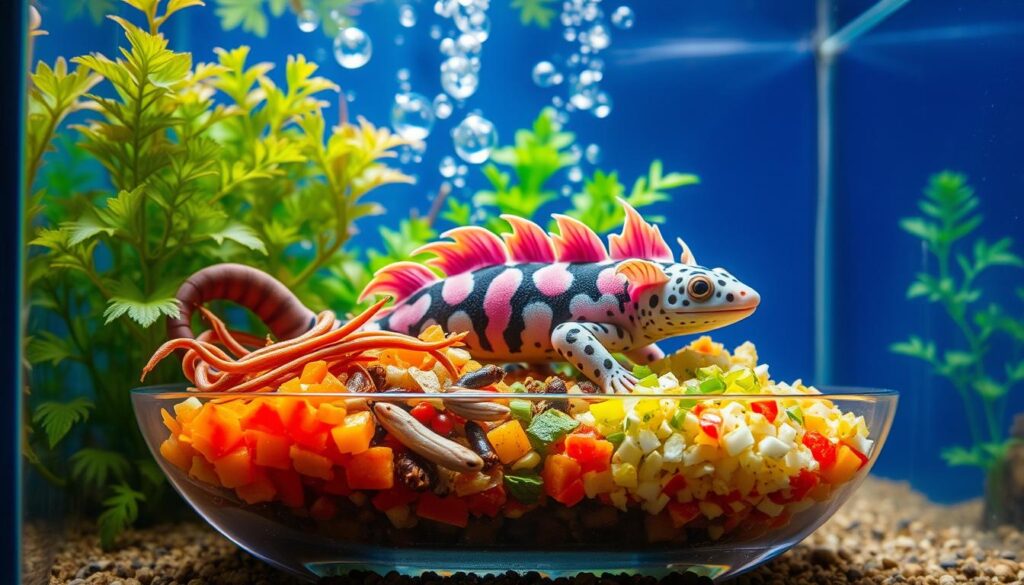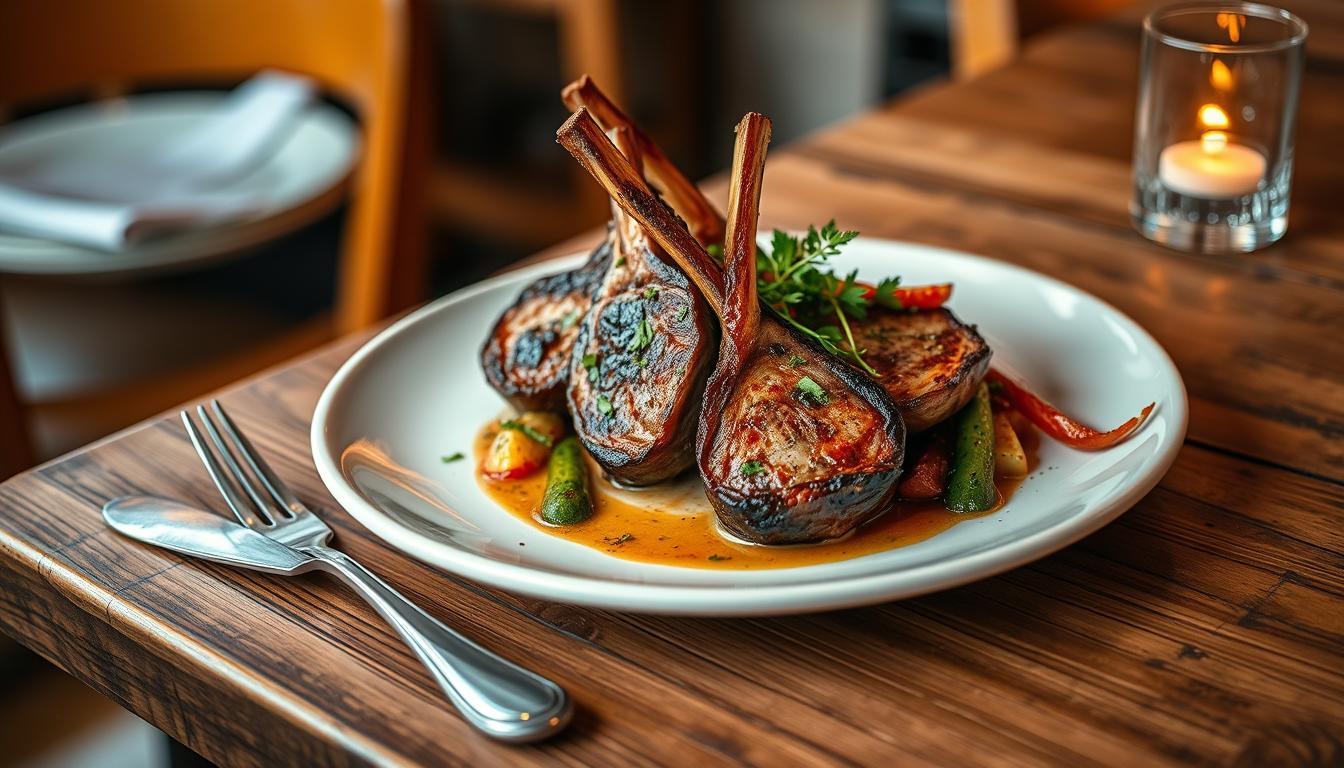Axolotl Food: Discover the Healthiest Choices

As an axolotl owner, you might be surprised to learn they are carnivorous. Their natural diet includes small fish, insects, and aquatic invertebrates1. It’s key to provide the best food for their health and happiness. In the wild, axolotls eat worms, tiny fish, snails, shrimp, and larvae2.
A nutritious diet for axolotls should mix live foods, commercial pellets, and frozen foods. This ensures they get all the nutrients they need.
Understanding axolotl dietary needs is crucial. They need a diet high in protein and low in fat. Live foods like nightcrawlers, bloodworms, and brine shrimp are great options2. A balanced diet is vital for their health, focusing on high protein1. The right food helps your pet thrive and live a long, healthy life.
Key Takeaways
- Axolotls are carnivorous and require a diet rich in protein and low in fat.
- Live foods like nightcrawlers, bloodworms, and brine shrimp are excellent choices for axolotls2.
- A balanced diet is critical for the health and well-being of axolotls, with a focus on high protein content1.
- Axolotl pellets provide a well-rounded and balanced diet for axolotls, convenient to store and serve in controlled portions2.
- Frozen foods like bloodworms, brine shrimp, and krill are highly nutritious and suitable for axolotls1.
- Proper feeding schedule for axolotls is feeding 2-3 times a week, adjusting portion sizes according to their size, and monitoring their eating habits1.
Understanding Your Axolotl’s Dietary Needs
As an axolotl owner, knowing what your pet eats is key. Axolotls are meat-eaters and need a diet rich in protein3. In the wild, they munch on insects, crustaceans, and small fish. You can feed them high-quality pellets and add live foods like earthworms and brine shrimp.
Axolotls need a diet full of protein and low in fat3. The pellets they eat are 45% protein and 20% fat, which is good for them3. Treats like brine shrimp and earthworms give them extra nutrients.
Natural Feeding Habits in the Wild
In the wild, axolotls eat insects, crustaceans, and small fish. This mix of foods helps them grow and stay healthy. You can give them a similar diet with pellets and live foods.
Essential Nutrients for Axolotls
Axolotls need a diet full of protein, vitamins, and minerals3. A diet high in protein and low in fat is best for their growth3. They also need specific vitamins and minerals to stay healthy3.
Age-Specific Nutritional Requirements
Young axolotls grow fast and need to eat every day4. Juvenile axolotls should eat 1-2 times a day4. Adult axolotls can eat 2-3 times a week4. Knowing these needs helps you feed them right.
Feeding your axolotl a balanced diet with pellets and live foods keeps them healthy. Always research their dietary needs and talk to a vet or breeder if you’re unsure.
Types of Axolotl Food Available Today
As an axolotl owner, you want the best for your pet. There are many food choices, making it hard to pick. You can find natural axolotl treats and healthy axolotl meal options at places like Simply Pets. They have a wide range of products for pets, focusing on quality and affordability. When picking food, think about your axolotl’s age, size, and what they need5.
Popular foods for axolotls include live foods, commercial pellets, and frozen foods. Live foods like earthworms and brine shrimp are full of protein and make great natural axolotl treats6. Commercial pellets are easy to use, but choose a brand with at least 40% protein and less than 10% fat5.
Axolotls need different foods at different times in their lives. Young axolotls like Daphnia and earthworms, while adults do well on pellets and sometimes healthy axolotl meal options like frozen foods6. To give your axolotl a varied and balanced diet, consider these options:
- Live foods: earthworms, brine shrimp, Daphnia
- Commercial pellets: high-quality brands with at least 40% protein
- Frozen foods: a convenient and nutritious option
By giving your axolotl a balanced diet, they can stay healthy and happy. Always choose high-quality food and talk to a vet if you’re unsure about their diet5.
Live Food Options for Your Axolotl
Feeding your axolotl live food is a great choice. Live food is a natural source of protein and easy to find. You can give your axolotl earthworms and bloodworms as treats. These foods are full of nutrients and help your axolotl grow strong. For more info on what to feed your axolotl, check out axolotl nutrition guides7.
Other live foods like brine shrimp or small fish are also good. They make your axolotl’s diet varied and nutritious. It’s important to know what your axolotl needs to eat best8.
Some people also give their axolotls natural treats like frozen or live foods. These treats add variety and important nutrients to their diet. Always pick high-quality, nutritious foods to keep your axolotl healthy7.
Commercial Pellets and Frozen Foods
Commercial pellets and frozen foods are great for your axolotl’s diet. They are easy to store and feed. This source shows axolotls do well with different foods, including live and frozen ones9.
Commercial pellets are nutritious and easy to use. They’re a safer choice than live foods, which can have parasites and diseases10. Look for pellets that are made for axolotls and have the right mix of nutrients.
Here are some tips for choosing the best commercial pellets and frozen foods for your axolotl:
- Look for pellets that are high in protein and low in fat
- Choose frozen foods that are rich in nutrients and low in contaminants
- Consider the age and size of your axolotl when selecting a pellet or frozen food
By giving your axolotl a varied diet with high-quality pellets and healthy foods, they can live a long and healthy life9.
| Food Type | Nutritional Content |
|---|---|
| Commercial Pellets | High in protein, low in fat |
| Frozen Foods | Rich in nutrients, low in contaminants |
Creating the Perfect Feeding Schedule
To make sure your axolotl eats well, you need a good feeding schedule. This schedule should match your axolotl’s age, size, and nutritional needs11. Small axolotls need to eat often, 2-3 times a day11. Adult axolotls, on the other hand, should eat once a day11.
Here are some tips for a good feeding schedule:
- Feed young axolotls every day, and those in between every 1-2 days. Adults can eat every 1-3 days to match their metabolism12.
- Break worms into small pieces for your axolotl. Make sure the pieces are no bigger than its head12.
- Don’t overfeed. It can harm the water quality and your axolotl’s health12.
Axolotls in the wild eat small creatures like insects and crustaceans. This diet is full of nutrients for growth13. For a healthy axolotl, give small, protein-rich meals 2-3 times a week13. The feeding schedule also depends on the axolotl’s age, size, activity level, and water temperature13.
Common Feeding Mistakes to Avoid

Feeding your axolotl the right food is key to their health. They need a diet rich in protein and nutrients. Avoiding common mistakes is crucial to prevent health problems14.
Give them a balanced diet with live or frozen foods. Commercial pellets made for axolotls are also a good choice15. Knowing their nutritional needs based on age and size is important.
Don’t overfeed or underfeed your axolotl. This can cause digestive issues and malnutrition. A balanced diet helps prevent these problems14.
Some mistakes to avoid include feeding too often or too little. Not providing a varied diet is also a mistake. Always check their weight and health15.
By avoiding these mistakes, you can ensure your axolotl stays healthy. For more care tips, visit petpawza. A healthy diet is vital for their well-being16.
By following these tips, your axolotl can thrive. Always focus on their nutritional needs. Provide a balanced diet with various nutrient-rich foods14.
Supplementing Your Axolotl’s Diet
To make sure your axolotl gets a balanced diet, you might need to add supplements. A good axolotl pellet is a solid base. But, adding supplements can boost the nutrition even more17. Look for vitamins and minerals that are key for your axolotl’s health.
Important supplements include vitamin D and calcium for bone health18. Also, phosphorus and omega-3 fatty acids are crucial for a healthy axolotl19. Knowing what your axolotl needs is key to giving them the best care.
Think about your axolotl’s age and size when deciding on supplements. Baby axolotls need food every day and might need extra nutrients for growth18. Juveniles and adults might eat less often and need fewer supplements18. Always talk to a vet or an experienced breeder to find the right supplements for your pet.
Choose high-quality supplements made for axolotls and follow the instructions carefully. Too much of a good thing can harm your axolotl. So, it’s important to find the right balance for a nutritious diet17.
Signs of a Healthy Diet in Axolotls

A healthy diet is key for axolotls to do well. You can tell if your axolotl is eating right by looking at its appetite, skin, and bowel movements. A healthy appetite means they’re getting the nutrients they need from natural axolotl treats and healthy axolotl meal options20.
Some important signs of a healthy diet in axolotls are:
- Good appetite
- Healthy skin
- Regular bowel movements
These signs show your axolotl is getting the right nutrients and can digest food well. A good diet is vital for their health and happiness21.
It’s also key to remember that axolotls need different foods at different times. Young ones need to eat twice a day, while adults can eat less often20. Giving them a mix of natural axolotl treats and healthy axolotl meal options helps them get all the nutrients they need21.
By watching what your axolotl eats and making sure they get the right nutrients, you can keep them healthy and happy. Always give them healthy axolotl meal options and natural axolotl treats to support their health and well-being2021.
Seasonal Changes in Axolotl Food Preferences
As an axolotl owner, it’s key to know that your pet’s food likes can shift with the seasons. In summer, axolotls get more active and need more protein-rich food22. But in winter, they move less and eat less, so their diet must change to meet their needs22.
Studies show axolotls need different foods at different times of the year23. For instance, during breeding season, from March to June, they need more nutrient-rich food for their health23. A varied diet, including live or frozen foods, keeps them healthy and happy.
Important things to think about for seasonal food changes include:
- Adjusting how much food you give based on their activity and needs22
- Offering a mix of foods for a balanced diet24
- Not overfeeding to avoid obesity and health issues22
Special Dietary Considerations for Breeding
When breeding axolotls, a nutritious axolotl diet is key for their health and fertility25. A high-quality axolotl pellet is a good start, but age and size matter too. Young axolotls need to eat 2-3 times a week until they’re 10 cm. Adults over 10 cm should eat 1-2 times a week25.
For breeding axolotls, a balanced diet is vital25. You can mix high-quality commercial pellets, live or frozen foods, and supplements. They need lots of protein, vitamins, and minerals for breeding25.
Here are some tips for a nutritious diet for breeding axolotls:
- Provide a variety of foods for a balanced diet
- Use high-quality commercial pellets as a main food
- Add live or frozen foods for extra nutrients
- Don’t overfeed to avoid health issues25
By following these tips, you can ensure your breeding axolotls stay healthy and fertile25.
Remember, a well-planned diet is essential for the success of your breeding program.
Conclusion: Maintaining a Balanced Diet for Your Axolotl
You now know how crucial it is to give your axolotl a balanced and nutritious diet26. You can choose from live foods, commercial pellets, or mix them up. The goal is to offer a variety that fits your axolotl’s special needs27. By following the tips in this article, you can make sure your axolotl gets all the proteins, vitamins, and minerals they need to stay healthy27.
Keep in mind, finding the right diet for your axolotl is a journey. You might need to try different things to find what works best for your pet26. Watch for signs that your axolotl is eating well. If you have any doubts, talk to a vet or someone who knows a lot about axolotls27. With the right axolotl food and care, your axolotl can live a long, joyful life26.
FAQ
What are the healthiest food options for axolotls?
What are the essential nutrients axolotls need in their diet?
What are the benefits of live foods for axolotls?
How do I choose the best commercial pellets and frozen foods for my axolotl?
How do I create the perfect feeding schedule for my axolotl?
What are some common feeding mistakes to avoid with axolotls?
How can I use supplements to enhance my axolotl’s diet?
How can I tell if my axolotl is on a healthy diet?
Do axolotls have different food preferences during different seasons?
What special dietary considerations are needed for breeding axolotls?
Source Links
- https://fishlab.com/what-to-feed-axolotl/ – Axolotl Feeding Guide: 10+ Best Foods to Feed Axolotl
- https://www.ouraquariumlife.com/fish/what-do-axolotls-eat/ – What Do Axolotls Eat? (Top 8 Nutritious Food)
- https://www.axolotl.org/feeding.htm – Axolotls – Feeding
- https://talis-us.com/blogs/news/essential-diet-for-healthy-axolotls?srsltid=AfmBOoo3_uJue9B8DtscejJojbbCaHEIqFUxAMXYK-M4t0pV_yc8mGhU – Essential Diet for Healthy Axolotls – Talis Us
- https://www.petmd.com/exotic/what-do-axolotls-eat – What Do Axolotls Eat?
- https://internationalpetfood.com/what-do-axolotl-eat/ – what do axolotl eat: The types of food that are both nutritional and enjoyable for axolotls – International Pet Food
- https://axolotlplanet.com/ – Axolotl Planet | Axolotls for Sale, Learn About Axolotls, and More!
- https://zoomed.com/axolotl/ – Axolotl
- https://www.animalbliss.com/axolotl-food/ – Axolotl Food: What Do Axolotls Eat? (What Can’t They Eat?)
- https://en.axolotls-cie.com/alimentation – Axolotls et cie,alimentation axolotls
- https://alottaaxolotls.wordpress.com/2018/09/21/axolotl-feeding/ – Axolotl Feeding
- https://axolotlplanet.com/blogs/all-about-axolotls/bringing-your-axolotl-home-acclimation-cycling-and-feeding – Bringing Your Axolotl Home: Acclimation, Cycling, and Feeding
- https://axolotlcareguide.com/axolotl-feeding-how-to-feed-a-axolotl/ – Axolotl Feeding Schedule and Tips for Optimal Health
- https://www.aquatana.ch/en/blogs/news/common-mistakes-when-keeping-axolotls – Common mistakes when keeping axolotls
- https://axolotlalley.wixsite.com/axolotlalley/diet – Diet | axolotlalley
- https://www.agamerswife.com/2018/02/axolotl-care-sheet-housing-feeding-and.html – Axolotl Care Sheet: Housing, Feeding, and Tank Mates!
- https://www.caudata.org/threads/axolotl-pellet-food-options.55213/ – Question: – Axolotl Pellet Food Options
- https://talis-us.com/blogs/news/essential-diet-for-healthy-axolotls?srsltid=AfmBOordBVDuwocATTPHK0fJDhgJWjxXFxIxrY24bAR9k50LAzjATm6P – Essential Diet for Healthy Axolotls – Talis Us
- https://zoomed.com/axolotl-food/ – Axolotl Food
- https://fantaxies.com/blogs/news/the-best-guide-to-axolotl-feeding-diet-tips – The Best Guide to Axolotl Feeding & Diet Tips
- https://talis-us.com/blogs/news/essential-diet-for-healthy-axolotls?srsltid=AfmBOopHOLh4mYJfApRP6w3PTj1glRr9yXHvS3Kja4LcHui6_c5y1SUL – Essential Diet for Healthy Axolotls – Talis Us
- https://axolotlcareguide.com/what-do-axolotls-eat-feeding-axolotl/ – What Do Axolotls Eat? A Complete Feeding Guide for Owners
- https://www.pbs.org/wnet/nature/blog/axolotl-fact-sheet/ – Axolotl Fact Sheet | Blog | Nature | PBS
- https://www.nationalgeographic.com/animals/amphibians/facts/axolotl – Axolotl | National Geographic
- https://www.aquatana.ch/en/blogs/news/the-perfect-diet-for-axolotls-everything-you-need-to-know – The perfect diet for axolotls: everything you need to know
- https://talis-us.com/blogs/news/essential-diet-for-healthy-axolotls?srsltid=AfmBOoo0frnlWpPabK0UzyCfxs4Cd0IY8zfrwkXCbjN7wblZeG5UXVRw – Essential Diet for Healthy Axolotls – Talis Us
- https://axolotlcareguide.com/axolotl-diet-foods/ – Axolotl Diet Explained: Foods to Keep Your Axolotl Thriving

